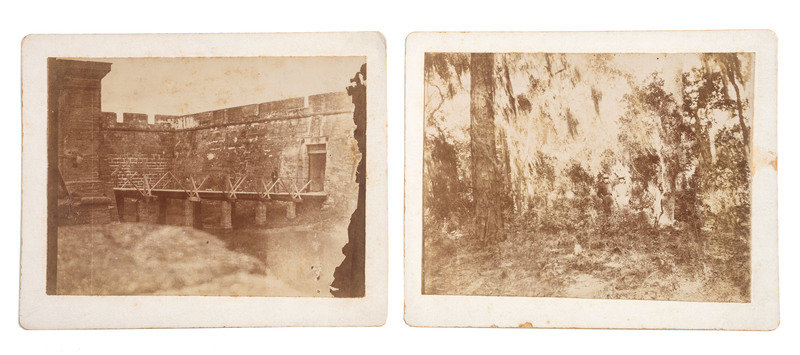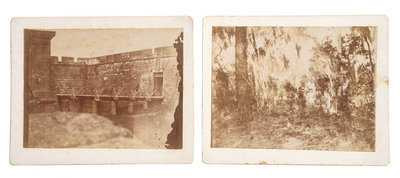[CIVIL WAR - PHOTOGRAPHY] Photograph of a soldier outside of Ft. Marion, Florida
Sale 960 - American Historical Ephemera & Photography
Nov 15, 2021
11:00AM ET
Live / Cincinnati
Own a similar item?
Estimate
$300 -
500
Price Realized
$188
Sold prices are inclusive of Buyer’s Premium
Lot Description
[CIVIL WAR - PHOTOGRAPHY] Photograph of a soldier outside of Ft. Marion, Florida
Two photographs of Ft. Marion and vicinity, Florida. Each 3.5 x 45 in. on 4.25 x 5.25 in. mounts. Photographer identified by consignor as Sam A. Cooley (1821-1900), a Connecticut native living in Beaufort, SC at the outbreak of war. He would become the photographer of the US Army 10th Corps, Dept. of the South. He took some of the first images of battles as the Union army moved into the Confederacy. One of these images shows a lone man on a walkway inside the fort. The other shows two soldiers, possibly state militia or Confederates, in the landscape outside the fort.
Even before secession, the Governor of Florida, M.S. Perry, had already decided to seize federal property within his state. He summoned his aide de camp Col. Richard Floyd and gave him orders to do just that. The Aide ordered about two dozen of the St. Augustine Blues to occupy the fort. Constructed by Spain between 1672-1695, what would be renamed Fort Marion (after Frances Marion, the Swamp Fox) is the oldest masonry fort in the continental United States. The Union forces left the fort leaving only Ordnance Sergeant Henry Douglas as caretaker. When the state forces formed at Fort Marion on 7 Jan. 1861, Douglas knew he was outnumbered, but he demanded a receipt for the stores that the soon-to-be Confederates seized. In his report to Col. H.K. Craig, Chief of Ordnance, US Army, Douglas wrote:
“I am obliged to perform what is to be a painful duty, viz, to report to the Chief of Ordnance that all the military stores at this place were seized this morning by the order of the Governor of the State of Florida. A company of volunteer soldiers arched to the barracks and took possession of me, and demanded peaceable possession of the keys of the fort and magazine. I demanded them to show me their authority. An aide-de-camp of the governor showed me his letter of instructions authorizing him to seize the property, and directing him to use what force might be necessary.
Upon reflection I decided that the only alternative for me was to deliver the keys, under protest, and demand a receipt for the property…. Henry Douglas, Ordnance Sergeant, U.S. Army.”
Col. Floyd also gave Douglas the US flag after he replaced it with a state flag. Since he did not even have a way to return home, the men took up a collection for Douglas to buy passage on the next north-bound steamer.
On March 11, 1862, the USS Wabash and USS Mohican steamed into the harbor and retook Fort Marion for the Union. The fort again had been abandoned by the larger body of troops shortly before the Union ships entered the harbor. It was used as a military prison throughout most of the war. After the war, it was still a prison, but housed many native Americans, including Geronimo’s band (but not Geronimo, who was sent to Fort Pickens).
Condition Report
Auction Specialist

